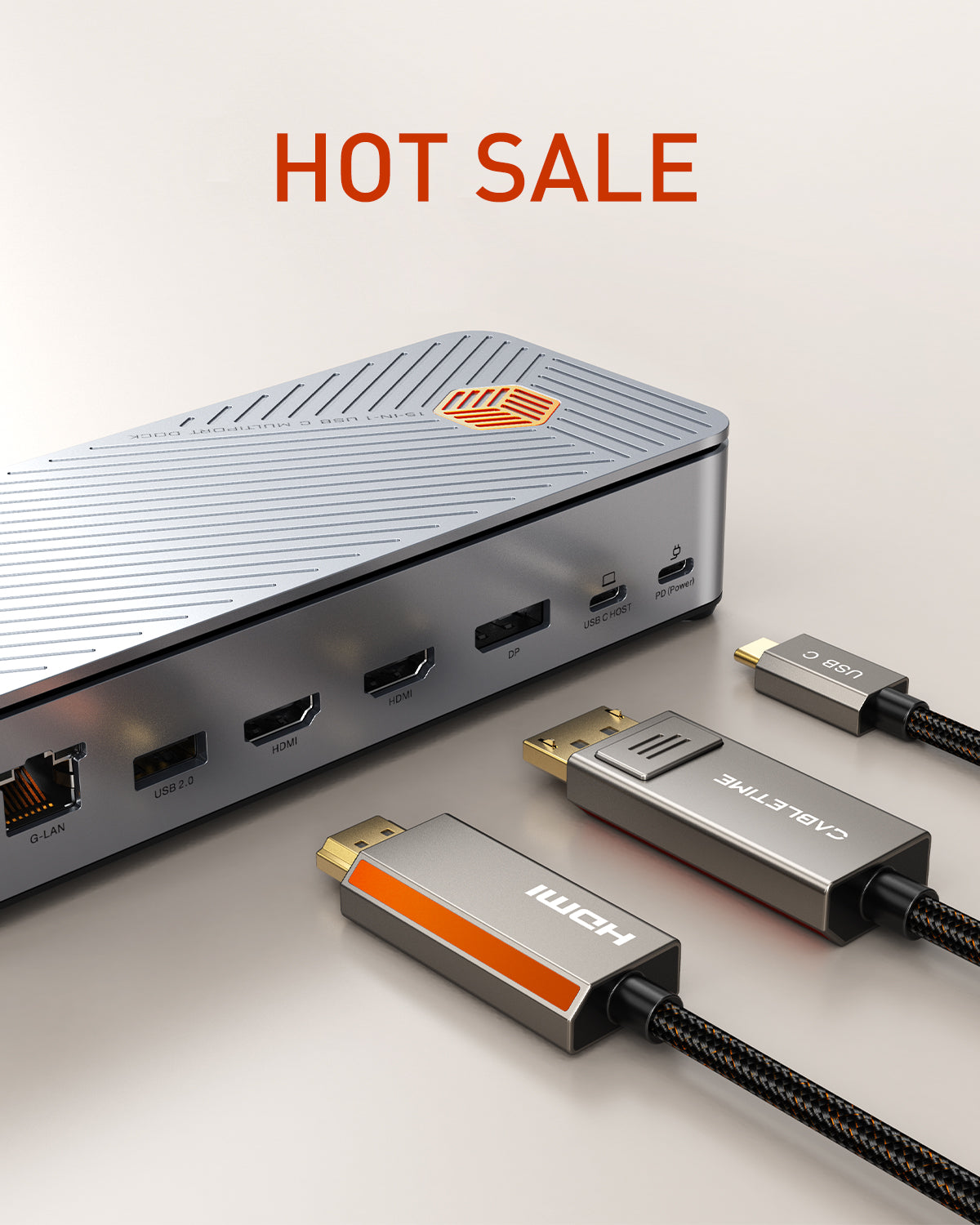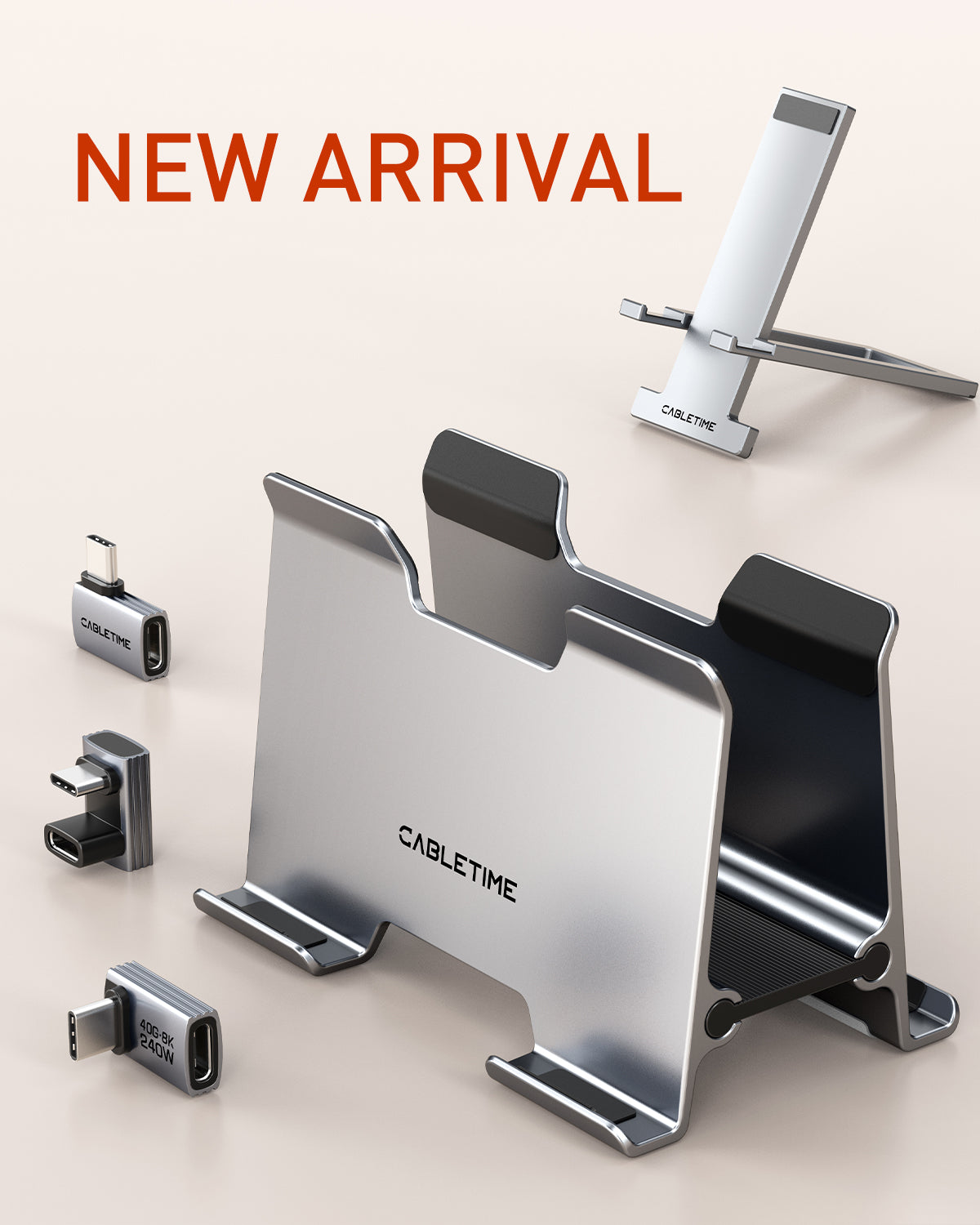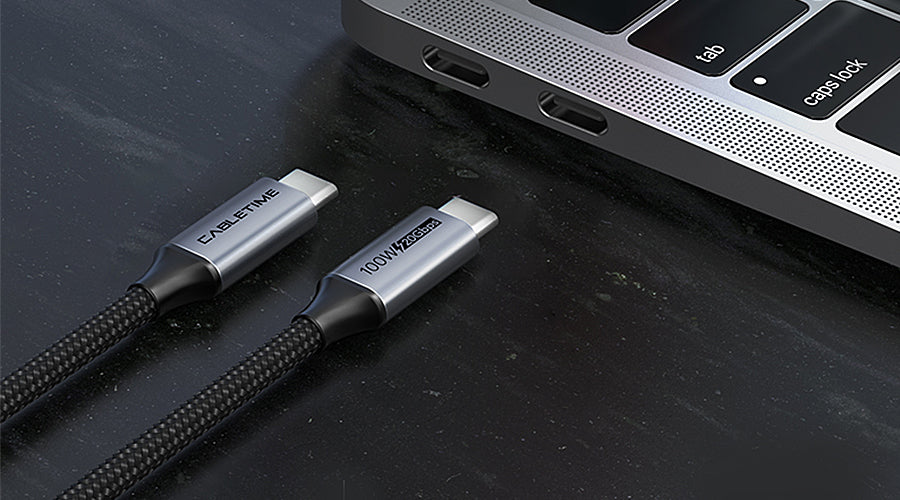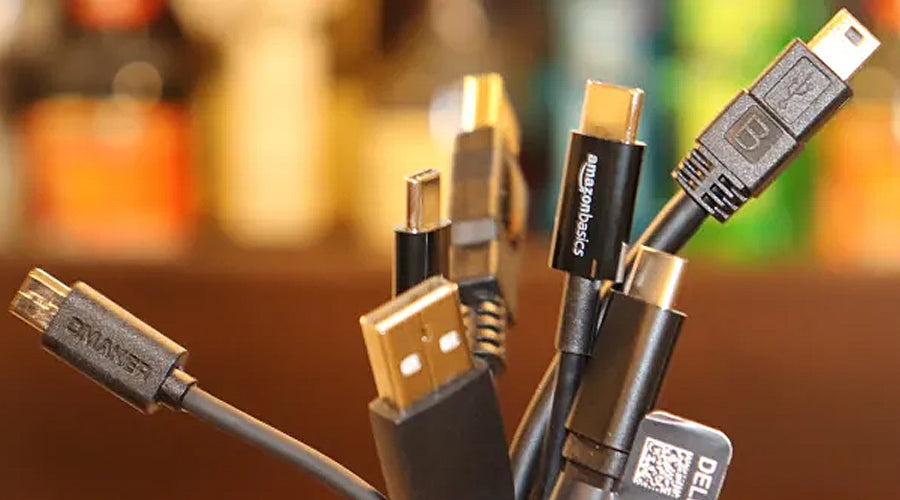Let us start by setting the scene. It's late at night and you're hunched over behind your desk, phone flashlight in hand, squinting at the tangled mess of cables snaking out the back of your computer. Sigh... this looks even worse than headphone wires after a cycle in the washing machine! But you soldier on, determined to trace each wire back to its source and impose some order on this chaos.
As you unravel each cable, you notice they don't all look the same. Some are thick, some thin. Some are tightly wound, others loose. And (check closely), they actually have different text printed on the plastic sleeving! Cat5, Cat6, Cat 7 - what does it all mean?
Well, friends, that's what we're here to unravel today (pun intended)! By the time we reach the end of this journey, you'll be a certified cable expert, easily able to strut into any networking closet like you own the place (which, if it's your house, you do!).
So plug in your phone, make sure you’re comfy, and let’s get untangling!
Table of content
- 1. A Crash Course on Ethernet Cable Categories
- 2. When Does Spending More on Ethernet Cables Make Sense?
- 3. Ethernet Cable Buying Tips
-
4. People Also Ask
- 4.1 What are the main differences between Cat6, Cat7, and Cat8 cables?
- 4.2 Can I use Cat8 cables for home networks, or are they only for data centers?
- 4.3 How does cable length affect the performance of Ethernet cables?
- 4.4 Is it worth investing in Cat7 or Cat8 cables for a small business?
- 4.5 What should I consider when installing Ethernet cables in a high-interference environment?
A Crash Course on Ethernet Cable Categories
In the simplest terms, Ethernet cables are used to connect devices together in a wired network. They transmit data in the form of electrical or optical signals. But not all Ethernet cables are created equal! Over the years, newer standards have been introduced that allow faster data speeds over longer distances.
These standards are defined by categories - Cat5, Cat5e, Cat6, Cat7, Cat8 etc. Each has its own specifications and capabilities. Think of it like grades in school - Cat5 was fine when the 'tests' involved basic browsing and email. But now with 4K Netflix and online gaming, we need to excel at 'Cat8' level to handle all that data!
Let's quickly recap the different "grade levels" of Ethernet cables:
- Cat5 - The first generation of Ethernet cables designed for 100 Mbps networks
- Cat5e - An improved version of Cat5, capable of 1 Gbps speed
- Cat6 - Supports bandwidth up to 10 Gbps, ideal for modern homes & offices
- Cat7 - Shielded cable for 10 Gbps in demanding industrial environments
- Cat8 - Latest standard supporting whopping 40 Gbps speeds
Still with us? Great! Now that we know the lay of the land, let's explore each cable category in more detail. Time to separate the A students from the backbenchers!
Cat6 Cables - The Reliable Workhorse

Think of Cat6 cables as the reliable family pet. They've been around for a while and might lack some of the fancier features of newer cables. But darn it, they just work! Even after being chewed on by the dog multiple times!
|
Parameter |
Cat6 Specification |
|
Max Speed |
10 Gbps |
|
Max Length |
55 meters (180 ft) for 10G speeds |
|
Shielding |
Unshielded |
|
Typical Use Cases |
Homes, small offices |
Some key things that make Cat6 cables so dependable:
- Speed - With support for 10 Gbps Ethernet, Cat6 handles modern home broadband speeds with headroom to spare. Even if you upgrade to a faster plan from your ISP, a Cat6 cable won't bottleneck your network.
- Distance - 55 meters (180 feet) is more than enough to wire up most homes and small offices. Only large warehouses or open spaces would require longer cable runs.
- Affordability - As an older standard, Cat6 cables are widely available and very affordably priced, especially compared to fancier Cat7 or Cat8 cables.
Much like that reliable family dog, Cat6 cables don't shine at any one thing, but do everything you need without much fuss.
For most home and small business networks, Cat6 is tried and tested enough to be the default choice when wiring things up. Unless you have specific needs that require Cat7 or Cat8 features, going Cat6 can save you some bucks without compromising on real-world performance.
Now speaking of fancier cables... let's check out what's new in the world of Cat7!
Cat7 Cables - The Brave Protectors
If Cat6 cables are like faithful family pets, Cat7 cables are more like vigilant guard dogs, standing watch to protect your precious data!
These cables provide enhanced shielding against electromagnetic interference (EMI) and crosstalk compared to Cat6, while still supporting 10 Gbps network speeds.
|
Parameter |
Cat7 Specification |
|
Max Speed |
10 Gbps |
|
Max Length |
100 meters (328 ft) for 10G speeds |
|
Shielding |
Shielded (S/FTP or S/STP) |
|
Typical Use Cases |
Industrial environments with lots of EMI |
The key benefits Cat7 cables provide through shielding:
- Noise protection - Special foil or braided mesh shields minimise interference from nearby power lines, machines, devices etc. This allows stable connectivity even in electrically noisy environments.
- Crosstalk prevention - Shielding and tighter twists in the copper wires reduces crosstalk between wire pairs in the cable itself. This improves signal quality over longer distances.
- Harsh environment readiness - Shielded cables stand up to rugged industrial conditions involving dirt, grime, liquids and outdoor exposure better compared to unshielded Cat6.
With these protective superpowers, Cat7 cables are quickly becoming the standard choice for industrial networks, data centers and harsh environment applications. The extra shielding does come at a small price premium over Cat6 - but brings value in noisy electrical environments where interference could otherwise wreck havoc.
Note that for everyday home use though, Cat7 shielding is often unnecessary overkill. Unless you live right next to a power substation, chances are your Netflix streams will do just fine over humble old Cat6!
Alright, we've covered the mainstream cable categories. Now it's time to enter enthusiast territory with the mighty Cat8 cable! This one amps everything up to 11 for extreme networking needs...
Cat8 Cables - The Blinding Fast Racers
If we had to compare Cat8 cables to an animal counterpart, it would undoubtedly be the cheetah. Sleek, muscular, supremely engineered for raw speed and power.
While both Cat6 and Cat7 top out at a healthy 10 Gbps data rates, Cat8 cables blow the doors wide open for:
40 Gbps and 100 Gbps speeds
Yes, you read that right - these cables are capable of transmitting data at up to 100 billion bits per second! Suffice to say, that's blindingly fast. Ever wondered how stock exchanges are able to execute high frequency trades in microseconds? That's thanks to networked systems wired up with Cat8 cables!
|
Parameter |
Cat8 Specification |
|
Max Speed |
40 Gbps (up to 100 Gbps) |
|
Max Length |
30 meters (98 ft) for 40G speeds |
|
Shielding |
Shielded (S/FTP or S/STP) |
|
Typical Use Cases |
High speed data centers |
Of course, with great speed comes great...distance limitations. Due to the extremely high frequencies involved, Cat8 cables top out at 30 meters distance when operating at 40 Gbps speeds. They also have strict bending radius requirements and complex termination procedures.
This means Cat8 cables primarily only make sense in high density data centers where server racks are close together. Complex shielding and four differential signaling pairs per cable ensure a clean signal at such frequencies.
So in summary - blindingly fast, but not very long legs. Just like an actual cheetah we suppose!
For almost all home and office scenarios, Cat8 would be severe overkill. Not to mention very expensive to purchase and properly install! Stick to Cat6 or Cat7 for your needs.
Now that we've got a solid overview of the different Ethernet cable categories available, let's switch gears and talk about how YOU can pick the right one!
Step 1 - Evaluate Your Network Speed Needs
We all love having the shiniest new toys. But as Responsible AdultsTM, let's have an honest conversation about what your usage looks like before choosing an Ethernet cable.
While it may sound cool to have "Cat8 100 Gbps cables" in your home, here are some numbers to give you perspective:
- Netflix 4K video streaming = 25 Mbps
- Xbox cloud gaming = 10 - 50 Mbps
- Average US household broadband connection = 100 Mbps
See where we're going with this? Unless you're rocking a 10 Gigabit per second broadband fiber line into your home, you likely don't need more than what Cat6 Ethernet cables can provide - 10 Gbps of data capacity!
And even with consumer grade 10G fiber making an emergence, installing Cat6 today will leave you plenty of headroom for the future. Those cables can handle 10G just fine for typical run lengths.
The key considerations here are your current internet speeds and any planned upgrades in the next 5-10 years. Keep the numbers in perspective - for most homes and small offices, Cat6 gets the job done now and into the foreseeable future. The latest and greatest Cat8 would be overprovisioning without tangible real world benefits.
Of course, if you have niche needs like high performance computing, data centers, heavy streaming workloads etc - those could benefit from upgrading to Cat7 or Cat8. We'll cover those use cases later!
For now, let's assume regular home use case. Once you know what internet speeds you need today and the next few years, choosing the right Ethernet cable category becomes a lot clearer!
Now onto the next important consideration - cable distances.
Step 2 - Measure Your Installation Distances
Here's another area most consumers overspec when it comes to Cat5 vs Cat6 vs Cat7 cables. How much actual cable length do you need?
Many people buy 100 foot cables when their router and computer are... 10 feet apart. We've definitely been guilty of over-provisioning cable lengths in the past too!
But as we discussed earlier, with higher speed Ethernet standards, maximum supported distances do come down over the same cable:
- Cat6 = 55 meters (180 feet) at 10 Gbps
- Cat7 = 100 meters (328 feet) at 10 Gbps
- Cat8 = 30 meters (98 feet) at 40 Gbps
So if you're going to buy fancy, expensive Cat8 cables for a home network, but run them at their max distance, your speed has to drop back down to regular old Cat6 levels anyway!
Moral of the story - measure actual required cable runs and leave a tiny buffer if you need to move stuff around in the future. No need to buy a 100 foot spool if a 6 foot patch cable will do.
Quick tip for home networks - a 25 foot Cat6 cable will cover practically any room to room wiring scenario without needing repeaters. That leaves you future flexibility without wasting money on unnecessary extra lengths!
Alright, you now know two key pillars of choosing the right Ethernet cable - required speed capacity and installation distance. Let's round up this decision framework with the other good stuff - budgets!
Step 3 - Have a Budget Friendly Mindset
Another quick reality check before you start shopping for cables. We all love nice things, but we also don't want to waste money!
- Cat6 cables cost $5-10 for typical lengths
- Cat7 cables are 2-3X more expensive
- Cat8 cables are 5-10X pricier!
If installed properly, higher rated cables will provide better shielding and higher frequency support. But you have to determine if paying that hefty premium makes sense for YOUR use case.
Let's say you have gigabit fiber internet, with your office network rack and work area 20 feet apart. Does splurging on Cat8 cables instead of Cat6 make any tangible difference here? Not really!
Or take typical home use case with Netflix streaming over WiFi. Does shelling out 5X more money on Cat7 vs basic Cat6 improve your video quality one bit? Nope!
See our point? Just because higher spec cables exist, doesn't always mean you should buy them! Stick within your budget constraints, focusing on what delivers utility for YOU rather than bragging rights.
To recap:
- Calculate your speed capacity needs
- Measure distance requirements
- Set a budget
Making decisions through this lens will save you a boatload of money without sacrificing real world performance!
That said, if money is no object to you or you have special high compute requirements - the extra spend COULD be worthwhile! Let's talk about those more advanced use cases next.
When Does Spending More on Ethernet Cables Make Sense?

We just covered why you generally don't need to overspend on Ethernet cables for typical home and small office networks. But are there cases where stepping up to more professional grade cabling brings benefits?
You bet! Let's look at a few examples.
High Frequency Stock Trading Networks
Ever wondered how financial firms make those millisecond quick automated trades to take advantage of fleeting market opportunities? Custom-built high-frequency trading (HFT) networks!
These specialized trading networks connect superfast servers with extremely low latency cables like Cat8. When millions of dollars rest on beating other firms by microseconds, no expense is spared on performance. 40G and even 100G ethernet cables are common in such environments despite their high costs.
In financial districts like New York, dedicated "dark fiber" lines snake out connecting top stock exchanges with major trading headquarters. Terabytes of live market data gets analyzed for patterns by AI algorithms. When opportunities emerge, offers get routed through the network instantly over Cat8 cables and snapped up at lightning speeds!
While out of reach for consumers, these mission critical money making machines do benefit greatly from premium grade cabling matched to their bleeding edge performance requirements.
Data Centers and Web Company Infrastructure
Another place you see a LOT of high end networking infrastructure is the data centers powering cloud applications, websites and online services we use everyday.
Companies like Amazon AWS, Microsoft Azure, Facebook, and Google have hundred thousand+ server farms supporting our apps! All those servers, storage systems and switches have to "talk" to each other at blistering speeds to keep services fast and smooth.
So while a Cat6 cable might do just fine wiring up your home WiFi router, it would choke trying to handle terabytes of data transfer between racks of servers!
Most modern data centers use either Cat7 or Cat8 grade cabling, with 40G, 100G and even 400G Ethernet (yep it exists) seeing increasing adoption. Marginal improvements in speed, reliability and latency makes a noticeable impact when scaled to hyperscale levels.
Of course, this is deep behind-the-scenes infrastructure invisible to us consumers! But just know those instant Facebook newsfeed updates, Netflix video starts and Google searches rely on some seriously heavy duty cabling under the hood!
Scientific Research Networks
Here's one more exciting example of bleeding edge network infrastructure pushing boundaries...CERN's Large Hadron Collider! This epic underground particle accelerator circulates beams of protons around a 16 mile track before smashing them together.
Sensors surrounding the collision point record petabytes of data about the "explosion" aftermath to further understand fundamental physics. Now running sensors and simulations capturing terabytes of data per second requires some ultra high performance cables shuttling that data to computers for analysis!
So while traditional Cat6 or even Cat7 cables seem pretty darn quick at 10 gbps to normal people like us, they are considered painfully slow bottlenecks for the data hungry LHC! Hundred Gigabit Ethernet cables pulling 100+ gbps feeds are increasingly being rolled out to keep up.
Just another reminder that for truly specialized high performance applications, money is no barrier to get that incremental edge in network speed!
Alright, so to summarize when investing in premium Ethernet cabling could pay dividends:
- High frequency automated trading systems
- Hyperscale data center networks
- Cutting edge scientific research infrastructure
Most consumers and commercial setups won't see tangible benefits from exceeding basic Cat6 or Cat7 performance. But some highly specialized scenarios do rely on bleeding edge standards like Cat8 for competitive advantage!
With that, you now have a solid understanding of different Ethernet cable category capabilities and where each makes sense! Let's round up everything we covered with some shopping tips...

Ethernet Cable Buying Tips
Ready to finally buy those cables and clean up your messy home network setup? Here are some handy tips!
Cat5 vs Cat5e vs Cat6? Always Pick Cat6!
- Don't buy outdated Cat5 - It caps out at 100Mbps which is too slow for modern networks. Cat5e supports up to 1Gbps if you're on a tight budget.
- Cat6 is the ideal mainstream choice - With 10Gbps capacity and standardization, it's reliable and future proof for home/office uses. Avoid the temptation to overspend on fancier cables if Cat6 fits your needs!
- Only buy shielded if essential - Cat6a and Cat7 shielded cables protect against interference, but cost 2-3X more. Verify you specifically need shielded before spending extra over basic Cat6.
- Purchase quality cables - Pay attention to cable quality - thicker copper gauge, sturdy construction, snag-free PVC jacket etc. Avoid the cheap thin cables that crimp easily. A little more upfront on quality saves headaches down the road!
- Measure length realistically - Don't buy 100 foot spools if you only need 6 feet patch cables. Leave some buffer for adjustments but don't over-purchase. Also, account for max distance specs of higher grade cables.
- Carefully install Cat8 - It uses shielded RJ45 connectors and requires special grounded termination. Improper installation can negate benefits. Not ideally DIY-friendly.
- Pay attention to cable bend radius - Don't kink cables sharply as it degrades internal data signals. Generous bends maintain performance. Velcro straps help prevent tight folds.
And those are our top tips for choosing the right Ethernet cable and having a smooth purchase experience! Let us know if you have any other cabling questions.

People Also Ask
What are the main differences between Cat6, Cat7, and Cat8 cables?
Cat6 cables are rated for gigabit Ethernet speeds up to 10Gbps over shorter distances, while Cat7 and Cat8 cables are designed for higher speeds and longer distances. Cat7 cables can support up to 10Gbps over 100 meters, while Cat8 cables can handle up to 40Gbps over the same distance. Cat8 cables also have better shielding and twisted pair construction for improved noise resistance and performance in high-interference environments.
Can I use Cat8 cables for home networks, or are they only for data centers?
Cat8 cables can certainly be used for home networks, but they may be overkill for most residential applications. Unless you have specific high-bandwidth requirements or plan to future-proof your network for emerging technologies, Cat6 or Cat6a cables should suffice for most home networking needs, including gigabit internet, streaming, and basic networking.
How does cable length affect the performance of Ethernet cables?
Cable length can significantly impact the performance of Ethernet cables, particularly at higher speeds. As the cable length increases, signal attenuation and interference become more pronounced, leading to reduced throughput and potential data errors. For example, Cat6 cables are rated for gigabit Ethernet up to 100 meters, but performance may degrade beyond 55 meters. Shorter cable runs generally provide better performance and reliability.
Is it worth investing in Cat7 or Cat8 cables for a small business?
The decision to invest in Cat7 or Cat8 cables for a small business depends on several factors, including current and future bandwidth requirements, network infrastructure, and budget. If your business relies on high-speed data transfers, video conferencing, or plans to upgrade to multi-gigabit internet in the near future, Cat7 or Cat8 cables may be a worthwhile investment. However, if your bandwidth needs are modest, Cat6 or Cat6a cables may be more cost-effective.
What should I consider when installing Ethernet cables in a high-interference environment?
When installing Ethernet cables in a high-interference environment, such as an industrial setting or near sources of electromagnetic interference (EMI), it's crucial to consider shielded cables like Cat7 or Cat8. These cables have additional shielding layers that help protect against external noise and interference, ensuring reliable data transmission. Additionally, proper cable routing, grounding, and bonding techniques should be employed to minimize interference and maintain signal integrity.






1 comment
Dintech ltd
Hello Sir /Madam this is Dintech ltd from Rwandan country ,
I hope this email finds you well,
We need to Quotation for Network Cable SFTP CAT 8
Leave a comment
This site is protected by hCaptcha and the hCaptcha Privacy Policy and Terms of Service apply.